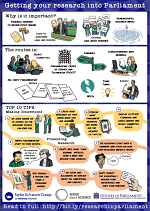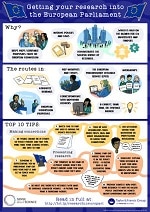Research impact
Research impact is an important topic in the research world. Use this guide to understand what impact means for you and your work, how to measure it, and get tips on sharing your article to increase its impact once it has been published.

Impact is about looking at the effects a piece of research has had. There are many different ways your research could have an impact depending on the nature of the work.
Some key terms and areas of impact are:
Academic impact
The impact research makes in academia, for example advancing and developing understanding, methods and theory within the field or across disciplines.Cultural or societal
The impact research can have on people, culture and society.Policy
The impact of research on policy formulation, for example using research as evidence to influence policy decisions.Economic impact
Impacting businesses and economic growth or development.Environmental
Impacting the environment – for example this piece of research which explores why having awareness and knowledge about climate change is not always enough for people to behave in a pro-environmental way.Health
Such as in the development of new drugs or influencing change in medical practice.

Different organizations and funders are interested in different areas of impact, bringing together one or many of these, and possibly others. Check the definition of research impact on your institution’s website and consider which areas of impact are important to you.
In the UK, for example, the REF (Research Excellence Framework) emphasizes the cultural or societal aspect, defining impact as “an effect on, change or benefit to the economy, society, culture, public policy or services, health, the environment or quality of life, beyond academia”.
Whether you’re an early career researcher on your first journal article, or later in your career, your curious mind may change the world. Read more here to discover how to impact the world with your research.
Research impact is an important topic in the research world. Funders, institutions, and researchers themselves are all interested in assessing the quality and impact of research. Some of the different reasons why impact is important are explained in more detail below.
Research funding
Governments providing public funding strive to ensure that research of the highest quality is produced, and that research can demonstrate a clear positive contribution to society. Being able to demonstrate impact allows them to continue to justify providing funding to research in this way.
For example, the REF (Research Excellence Framework) is the UK’s system for assessing the quality of research in UK HE institutions. Impact will be worth 25% in the REF2021 assessment which is used to allocate funding of research in the UK. Find out more about the Research Excellence Framework.

Impact in research grant applications
Most funding councils and bodies ask for evidence of impact in their funding applications to help make sure that research they’re investing in delivers as many benefits as possible.
How is research impact linked to your career?
Demonstrating the impact of research can help you develop your career as a researcher, whether that be increasing your academic profile, or providing evidence of impact when applying for grants or positions that will allow you to take your career to the next step.
Some examples of impact you might explore
Communication skills you gained through presenting at a conference, or running a public engagement activity.
Project management, gained by coordinating a project with a wider team.
Using quantitative and qualitative information to make evidence-based decisions.
Impacts activities on your CV
If you’re applying for an academic position, Vitae have some useful guidance on creating an academic CV. The guidance includes ideas on how you might document impact activities on there as well as examples of CV’s from other researchers.
Research Impact Collection

We are delighted to showcase the work of expert authors, across the human, social and natural sciences, around the red hot topic of research impact.
Our global portfolio of books and journals contains countless insights into research impact, whilst increasing awareness and understanding. The collection also provides practical tips for researchers around the world.
During the writing process, there are techniques you can use to increase your research paper’s visibility once it’s been published, helping to drive your research impact.
Write a good title for your research paper
A good title is specific and includes key words that readers might be searching for. Try to make it understandable to a reader from outside your field and, where possible, avoid abbreviations, formulae, and numbers.
Read our guide to writing titles and abstracts
Select relevant keywords
Selecting relevant keywords for your research paper will help others find your research quickly and accurately. Think of them as labels for your article. When you submit your article, you’ll be asked to provide keywords. These will be used to index your article on Taylor & Francis Online and on search engines such as Google Scholar™.
Find out more about selecting relevant keywords
Optimize your paper for search engines
Selecting relevant keywords is one technique for optimizing your paper for search engines (i.e. making it more searchable online), but there are other things you can do, like including reputable external links to build connections online.

Share the results of your scientific research with policy-makers
Taylor & Francis have launched Key Policy Highlights on selected journals across the Life, Earth & Environmental Sciences. Through this scheme, authors are able to publish a secondary abstract called ‘Key Policy Highlights’, as part of the scientific research paper. This secondary abstract communicates the significance of scientific research evidence in jargon-free and clear language, to a non-scientific audience.
Find out more about Key Policy Highlights and the participating journals
Early inclusion in citation indexes for Taylor & Francis articles
This Taylor & Francis led development will increase the early discoverability of articles published in our Web of Science indexed journals.
For many journals, articles are published online before they are assigned to a particular issue and page numbers are added. This is sometimes called ‘online first’. These papers, which you’ll find in a journal’s ‘latest articles’ section on Taylor & Francis Online, can be read and cited immediately.
However, the well-known Web of Science (WoS) indexes, such as the Science Citation Index and Emerging Sources Citation Index, have not previously listed these latest articles, from any publisher, until they become part of a paginated journal issue.
Now, authors who publish with Taylor & Francis won’t have long to wait before their article appears in the WoS. This means that readers who use Web of Science to look for related research will now find these latest articles in their search results, increasing the opportunity for this work to be read and cited.

Promoting your research article can help you increase your impact as a researcher. It can encourage your peers to use your work, generate greater awareness of it, and develop your professional profile and reputation.
There are many different tools and approaches for doing this, so here are some ideas to get you started.
Use social media to promote your article
Researchers are increasingly turning to social channels to help share their research. As a first step, check to see which platform your peers and intended readership are using and engaging with the most – you don’t need to be active on all the channels.
Here are some quick tips for promoting your article on some of the key social media platforms (X, Facebook, and LinkedIn).

Announce your published work along with a link to your article.
Tag co-authors, your publisher (e.g. @tandfonline), funder and institution, and anyone else you think might be interested in your paper. For X you can post multiple times a day, whereas Facebook and LinkedIn once per day is optimum.Include hashtags that your intended audience are using.
Doing a little research on X beforehand to find the best ones to use. This will make your tweet part of a bigger conversation, meaning you might reach an even wider audience for your research. If you’re attending a conference use the conference hashtag (e.g. #ScholarlySummit) to discuss ideas raised during the conference, as well as to make connections during and afterwards.Consider including a relevant and engaging image, gif or video to represent your article, as this can make posts more appealing and encourage people to read and click. Also, make sure the image is copyright free before using, or ensure to give credit to the artist.
Avoid technical jargon, and translate your research into 1 or 2 sentences that non-experts can understand.
Find out more about using Twitter, with our guide for researchers
Join an academic research sharing network

There’s a range of research sharing and networking sites out there that many researchers take advantage of to share their research and raise their profile. Some of the common ones that you might be familiar with are:
ResearchGate
Mendeley
Academia.edu
Loop
If you have a profile on any of these platforms, then add a link to your article on your profile.
Not sure which version you can post? Find out how you can share your work.
Create a Google Scholar profile
Google Scholar is a popular search engine for finding scholarly literature, so adding your articles and publications to your Google Scholar profile can help drive the readership of your work. Be sure to make your profile ‘public’ when you create it.
Here are some useful step-by-step instructions for creating a Google Scholar profile.
Write a blog post
Work on your writing skills by refining a paper or thought process into a blog post, while at the same time driving the impact of your work.
Read our guide for writing an academic blog post, including how to structure it and some examples.
Create a video abstract
A video abstract lets you introduce readers to your article in your own words, telling others why they should read your research.
These short videos (three minutes or less) are published alongside the text abstract on Taylor & Francis Online and are an increasingly popular way of getting others to engage with published research, increasing the visibility of your work.
Find out more about creating a video abstract.

Share your eprints
An eprint is a free, online link to an author’s article sent to all authors who publish in a subscription-based Taylor & Francis or Routledge journal as soon as their article is published. Authors are sent the link via email and can access it at any time from Authored works, as well as check how many they’ve used.
Discover some of the ways you can share your eprint to drive impact.
Present your paper at a conference
Attending and presenting at conferences can help make other researchers more aware of your work. We’ve put together a guide for how to get the most out of academic conferences, including how to present at conferences for maximum impact.
Read our guide to academic conferences.
Speak to your librarian, use your networks
Check your institution has a subscription to the journal you published in. If not, recommend it for the next subscription year. Get your students reading and talking about your article. How? Add it, or the journal it’s included in, to your course’s essential reading list.

Include your article in your email signature
Why not include a link to your research in your email signature, alerting everyone you email to your latest article? Many people you contact professionally are likely to be working in the same or similar fields as you. This is a quick and easy way to tell them you’re published.
If you’d like a banner to use in your emails, then just add the details of your article to our self-service form. Your personalized banner will be automatically generated and ready to you to download.
Update webpages
Lots of people browsing your institutional and departmental websites?
Use this to your advantage by adding a link on your departmental profile page, directing people to your latest article.
Explore our blog posts on making an impact

While most researchers would love their work to have a real-world impact, the first step to achieving this is to…

Networking can be challenging for a lot of people, often it doesn’t come naturally, and it is especially tricky to…

As a researcher, the hard work doesn’t stop once your research is published. Part of your job is to self-promote…
Understanding article versions
If you’re publishing in a Taylor & Francis or Routledge journal, there are many ways you can share your work with colleagues and peers. Before sharing your article, it is important to understand the options available for different versions of your article.
Author’s Original Manuscript (AOM)
The AOM is your original manuscript (sometimes called a preprint) before you submitted it to a journal for peer review.Accepted Manuscript (AM)
The version of a journal article that has been accepted for publication in a journal.Version of Record (VoR)
A fixed version of a journal article that has been made available by a publisher, by formally and exclusively declaring the article ‘published’.
Read our guide to find out how you can share different versions of your article.

Share your eprints
All authors who publish in a subscription-based Taylor & Francis or Routledge journal will get 50 free eprints (a free online link to your article) to share with interested readers.
From sharing on social media to adding to your institutional webpage, there are lots of ways you can share your eprints to boost your article visibility.
Authored works
Authored works is our dedicated center for all authors who have published in a Taylor & Francis journal.
Authored works is where you can download the PDF or view the HTML of your article, get your free eprint link to share with friends and colleagues, check the latest download figures, and more.
To access your Authored works, simply log in to Taylor & Francis Online, select ‘Your account’ from the top menu, select ‘Account settings’ and then you’ll find Authored works as an option in the left-hand menu.

All the articles you have published on Taylor & Francis Online will be listed here, with their associated readership and citation data. You can also keep track of how many free eprints you have left, and easily post an eprint directly to X, Facebook, or LinkedIn using the social share buttons.
Open access options
We offer a range of open access options, from open research platform F1000Research to hybrid and open access journals. You can either choose to publish gold open access or make your article available via green open access options.
Find out more about publishing open access
Link between clinical trials and journal articles
If there’s a registered clinical trial associated with your research article, a Taylor & Francis Online feature makes this connection clear for readers. Using Crossref Linked Clinical Trials, a permanent link will be established between your published article and any trials it reports on.
We now share details about clinical trial registrations with PubMed and Crossref, which improves the discoverability of your work. The increased transparency also supports reproducibility of published results.
When readers click the ‘Crossmark’ logo underneath an article title, a popup lists the clinical trials relating to that article. It also includes details of other articles related to those clinical trials, helping readers discover the network of reports about the trial data you’ve used. Users of Taylor & Francis Online can find the details of trial registration, as well as any other articles associated with those trials, by clicking the Crossmark logo on the article page.

As a researcher, you’ll be used to gathering facts and evidence to back up the claims you make in your work. The same is likely to be true of the work you put into improving the impact of your research.
There are a lot of metrics that can allow you to measure impact, but knowing what each one can tell you and how to interpret the data can be challenging. We’ve put together some resources to help you to use and understand these metrics, and most importantly, how to use them in combination to build a full picture of the impact your research has had.
Article-level metrics
Each individual article you publish will accrue data about how many times it has been downloaded, cited, and talked about or referenced outside of the traditional channels.
Read more about article-level metrics, including the Altmetric Attention Score.

Journal-level metrics
Your work contributes to, and can benefit from, the impact potential of the journal you publish in. The impact profile of a journal might be an important consideration for you when choosing where to publish.
Our extensive guide to journal-level metrics will help you to learn more about these metrics, including weighing up the pros and cons.
Research communication can sometimes called ‘science communication’ too. It involves communicating your research in an engaging and understandable way to those outside of academia. But it goes beyond just communicating your final article or results, it’s about managing communication with stakeholders throughout the entire research process. As a Sense about Science guide recommends, ‘Involve the public. And involve them early’.
Why is research communication important?

Research communication is important for several reasons, not least because it’s about giving back to society and demonstrating the value of research that public funds often support.
“I think that decision makers and society in general needs to have access to what we do at a level that they can understand, and that they can connect the dots of why it is important to support the scientific and the research enterprise.”
– Gabby Silberman, Director General of the Barcelona Institute of Science and Technology
How to communication research
Consider your audience
Think about how to pitch your project to people coming from different backgrounds.Simplify your language
Save the elaborate language for academic papers and specialist conferences.Present your work… earlier on in the project
“While many universities encourage students to present papers at conferences only from the second year of doctoral research onwards, my experience shows that it can be beneficial at an earlier stage too.”
Discover more tips for communicating your research from Postdoctoral students from the London Arts and Humanities Partnership.
The winners of the Vitae 3 Minute Thesis Competition (3MT®) are researchers who have mastered the art of research communication. Read advice from previous 3MT® winners, and watch their award-winning presentations.
Despite its importance, engaging with policymakers is not straightforward and there isn’t one clear route for doing it. So, we’ve put together some tips for how you might approach it.
Tips for engaging with policy makers
Invest time to finding out who is making the policy decisions relevant to your research. Follow what they are doing on their websites, via Twitter, go to their events (and invite them to yours!). Make sure that you are visible online so policymakers can find you.
Prepare your research in a way that is relevant to policymakers. For guidance on structuring a policy brief, use our template.
“A one-page summary, with key findings/ recommendations & top-line research context is ideal for initial comms.
Pitch your comms at an intelligent, non-specialist audience. Lose the jargon, & use bullet points, headings & charts to make it accessible & digestible.” – Sarah Foxen, Knowledge Exchange Unit, UK Parliament“So what?” What is the policy problem that your research can help to solve? Don’t tell policy makers what you want, ask them what they need.
Use your networks. Find out if your institution has an outreach officer. Contact the policy officer of your scientific society or professional association.
Understand the context of the policy. Your research will never respond to the entire policy question, so try to understand the bigger picture of the problem that your research is looking at. Be honest about limitations and caveats.
Consider adding a secondary abstract to your paper. Clearly communicate the significance of your research via Key Policy Highlights to support the uptake of your research into decision-making.
Writing a policy brief
A policy brief is a short, simple overview of your research findings, with terms and language that can be understood by non-specialists.
When is a policy brief useful?
When figuring out if a policy brief would be useful, a good question to ask yourself is, who would benefit from engaging with my research? Here are some situations where policy briefs can be beneficial.
If your research relates to a topic or policy issue that is under review, or if it is being developed by policy/decision makers.
If you want to show a non-specialist audience how your research helps with the issue or topic they’re working on.
To show that your work is realistic, credible, and relevant to a non-specialist audience.

Many of our journals now publish Key Policy Highlights or Plain Language Summaries. These are both great ways to communicate your research to a wider audience.
We also publish ‘Policy Briefs’ as an article type on our open publishing platforms: F1000Research and Routledge Open Research
Things to consider
Those working in policy often work to short timescales. They need information to be presented in a concise way, and on time, to be able to inform their decision-making process.
Policymakers are not always specialists. Be sure to present your research using terms and language that a non-specialist audience can understand.
Your expertise is valued by policymakers, but not necessarily your opinion. Aim to present your information in an impartial way, rather than advocating for a particular position.
How do you structure a policy brief?
We have created a simple template that you can download and use, to help structure your policy brief. You should keep your policy brief short, it should be a maximum of 2 pages.
The key elements to include in your brief are:
Title – make this memorable, engaging, and not too technical.
Contact details – including these will encourage interactions.
Key insights – convey the key points from your research, and summarize the elements of your research that have the most relevance to the policy issue or topic.
Research background – summarize your research and its focus. Convince your audience of the robustness of your research, and how it will help with the topic they are exploring.
Recommendations – outline possible approaches to address the problem or topic. Try and keep this as impartial as possible.
Visuals – include any visuals that may help your audience understand your research. Remember to include alt text on all visuals that you include.
References – cite your original research and be sure to include related resources and information. References reassure readers that your brief is based on robust information.

Further reading on policy briefs
Working with UK parliamentarians
If you want to work with UK parliamentarians then read our guide, ‘Getting your research into the UK Parliament‘, featuring expert tips from POST (Parliamentary Office of Science and Technology) on how to get your research policy-ready for UK government.
There’s also a wealth of useful advice on the Research impact at UK Parliament hub.
Getting your research into European parliamentarians
If you think your research is relevant to EU policy, then read our guide ‘Getting your research into the European Parliament’.
Different routes into the European Parliament include:
Via the EPRS (The European Parliamentary Research Service)
European Commission proposals
MEP initiatives
Intergroups
Engaging with the media is one of the best ways to raise awareness about your research to the public and policymakers.
Not all research articles may the grab the attention of a busy and increasingly-pressured journalist however, and some do have a better chance of piquing their interest than others.
Read our step-by-step guide which explains why and how you can work with the media to increase your research impact.

One of the biggest barriers we hear from authors who feel cautious about working with the media is they are concerned that press activity will attract criticism around their article.
If you (or someone you know) do become a victim of online harassment, read the updated advice from the Science Media Centre for support and tips, including how to deal with social media harassment.


